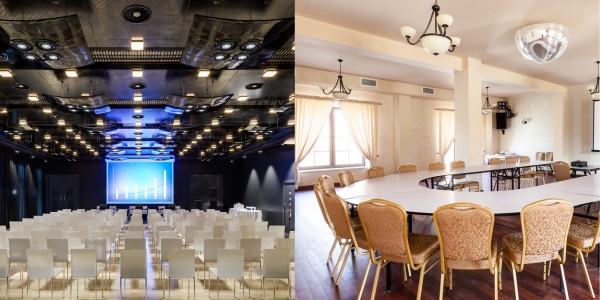Presented by the RFP® Valet Team

This sequel to last month’s Audience-Focused Fundamentals, presents seating ideas that will center attention on your audience. Most organization members say they attend conferences to learn something new and network with peers.
Here are some room set-up tips to advance audience participation and satisfaction.
- Because no one wants to sit in the first row, position the podium against the long wall to shorten the distance between the attendees in the back row and presenter.
- Curve your seating half-moon style so attendees can see each other. Make sure all chairs are facing the presenter.
- Aisles should be set at 10:30 and 1:30, with a narrow aisle cut into the middle from the back to roughly the third row for welcoming and unobtrusive seating access.
- Instead of an aisle behind the last row, place the last row of chairs against the back wall with ample leg room for attendees to walk through and take a seat.
- Go Modular: Use Movable FurnitureOpt for chairs that are easy to rearrange. Sessions can shift from lecture to workshop style, so seating should flex with the format. Bonus: rearranging a room energizes attendees and keeps them alert.
- Ditch the “Chair Parade”Avoid long, uninterrupted rows of chairs—it discourages interaction. Break rows into sections of 6–8 chairs with mini-aisles in between. People are more likely to chat with their “pod,” and it makes late arrivals less disruptive.
- Standing Zones & Lean BarsFor quick sessions or networking-heavy events, integrate standing zones or high-top tables. This adds energy and encourages more fluid conversation (also a win for folks with back issues!).
- Use Lighting to Set the ToneSoft spotlighting on the presenter is great, but don’t leave the audience in the shadows—literally. A warmly lit room makes people feel more comfortable and alert. Avoid full blackouts unless you’re screening videos (not horror movies).
- Sound Check Their ExperienceMake sure the presenter’s mic is audible from every corner. Bad sound is the fastest way to lose your audience (second only to bad coffee). Consider adding ceiling or side speakers in wider rooms.
- Facilitate Flow: Mind the Exit RoutesMake sure your setup allows attendees to easily slip out for calls or breaks without creating a scene. Bonus: If people don’t feel trapped, they’re actually more likely to stay engaged.



